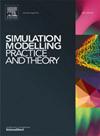How periodic forecast updates influence MRP planning parameters: A simulation study
IF 3.5
2区 计算机科学
Q2 COMPUTER SCIENCE, INTERDISCIPLINARY APPLICATIONS
引用次数: 0
Abstract
In many supply chains, the current efforts at digitalization have led to improved information exchanges between manufacturers and their customers. Specifically, demand forecasts are often provided by the customers and regularly updated as the related customer information improves. In this paper, we investigate the influence of forecast updates on the production planning method of Material Requirements Planning (MRP). A simulation study was carried out to assess how updates in information affect the setting of planning parameters in a rolling horizon MRP planned production system. An intuitive result is that information updates lead to disturbances in the production orders for the MRP standard, and, therefore, an extension for MRP to mitigate these effects is developed. A large numerical simulation experiment shows that the MRP safety stock exploitation heuristic, that has been developed, leads to significantly improved results as far as inventory and backorder costs are concerned. An interesting result is that the fixed-order-quantity lotsizing policy performs—in most instances—better than the fixed-order-period lotsizing policy, when periodic forecast updates occur. In addition, the simulation study shows that underestimating demand is marginally more costly than overestimating it, based on the comparative analysis of all instances. Furthermore, the results indicate that the MRP safety stock exploitation heuristic can mitigate the negative effects of biased forecasts.
周期性预报更新如何影响MRP计划参数:模拟研究
在许多供应链中,目前数字化的努力已经改善了制造商和客户之间的信息交换。具体来说,需求预测通常由客户提供,并随着相关客户信息的改进而定期更新。本文研究了预测更新对物料需求计划(MRP)生产计划方法的影响。针对滚动水平MRP计划生产系统中信息更新对计划参数设置的影响进行了仿真研究。直观的结果是,信息更新导致MRP标准的生产订单受到干扰,因此,开发了MRP的扩展以减轻这些影响。大型数值模拟实验表明,提出的MRP安全库存开发启发式方法在库存成本和缺货成本方面有显著改善。一个有趣的结果是,在大多数情况下,当发生定期预测更新时,固定订单数量的lotsizing策略比固定订单周期的lotsizing策略执行得更好。此外,基于对所有实例的比较分析,仿真研究表明,低估需求的成本略高于高估需求的成本。此外,研究结果表明,MRP安全库存开发启发式方法可以减轻有偏差预测的负面影响。
本文章由计算机程序翻译,如有差异,请以英文原文为准。
求助全文
约1分钟内获得全文
求助全文
来源期刊

Simulation Modelling Practice and Theory
工程技术-计算机:跨学科应用
CiteScore
9.80
自引率
4.80%
发文量
142
审稿时长
21 days
期刊介绍:
The journal Simulation Modelling Practice and Theory provides a forum for original, high-quality papers dealing with any aspect of systems simulation and modelling.
The journal aims at being a reference and a powerful tool to all those professionally active and/or interested in the methods and applications of simulation. Submitted papers will be peer reviewed and must significantly contribute to modelling and simulation in general or use modelling and simulation in application areas.
Paper submission is solicited on:
• theoretical aspects of modelling and simulation including formal modelling, model-checking, random number generators, sensitivity analysis, variance reduction techniques, experimental design, meta-modelling, methods and algorithms for validation and verification, selection and comparison procedures etc.;
• methodology and application of modelling and simulation in any area, including computer systems, networks, real-time and embedded systems, mobile and intelligent agents, manufacturing and transportation systems, management, engineering, biomedical engineering, economics, ecology and environment, education, transaction handling, etc.;
• simulation languages and environments including those, specific to distributed computing, grid computing, high performance computers or computer networks, etc.;
• distributed and real-time simulation, simulation interoperability;
• tools for high performance computing simulation, including dedicated architectures and parallel computing.
 求助内容:
求助内容: 应助结果提醒方式:
应助结果提醒方式:


